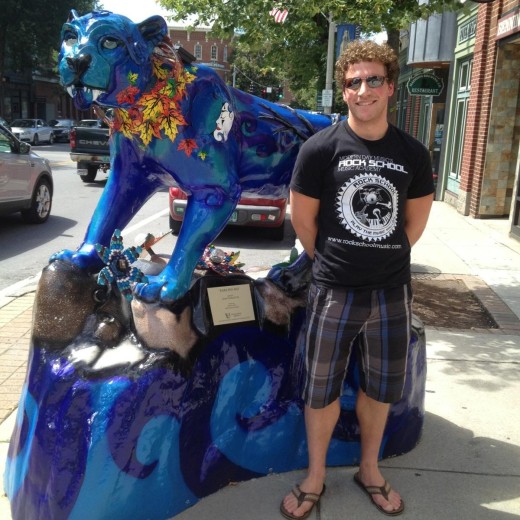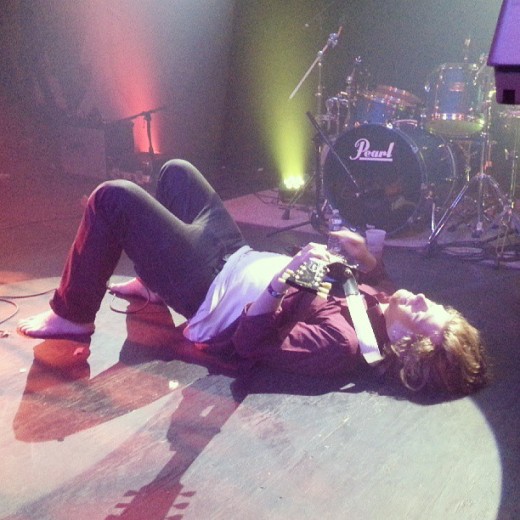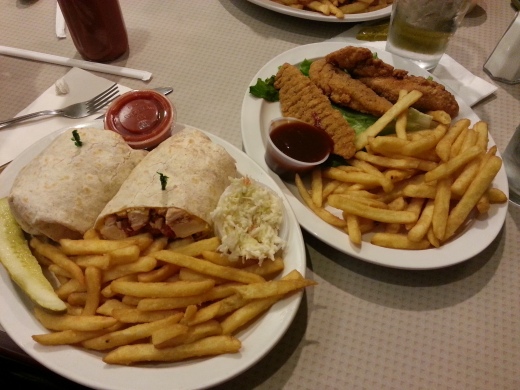Author Archives: Upvote Models
Welcome to Bennington, VT

Memorial Day Storms – Albany, NY – 5/24/13

Well, it just wouldn’t be Memorial Day in Upstate New York without heavy rain, ominous clouds, and unseasonably cold temperatures. Saturday night could get down to 40F, and there will be pretty much be consistent rain today (5/24) through tomorrow. We’ll see about Memorial Day. (photo, David Lombardo, I-88)
Pizzas on Lark Street

Anyone know this business on Lark Street, Albany, NY?
Derek Rogers of Titanics

Derek Rogers of Titanics
Latham 76 Diner

My friend said he would pay for dinner this weekend. Naturally, I bought two dinners. For myself. Latham 76 Diner. It will always be a favorite.
Make Your Band (or music) Go Viral
Here I explain some basic techniques for helping your band/artist page go viral on the internet
Amateur Music Video 101: Tips, Tricks, and Lessons Learned
So you have a band. You have a great song. It is blowing up on iTunes, Facebook, Twitter, Google, you name it. Things are going great, and labels/promoters have given you quite the look; they are interested in booking you at their venue. A lot of bands have this happen daily. It works out well for them. And then boom, they hit what I call the EGS, or the ‘entertainment glass ceiling’. Truth be told, if you are an artist or involved with the entertainment industry in some way, you have felt this. Yes, it is a feeling: something of a ‘great. what now’?
There is uncharted territory for many, many bands that I have worked with over the years, and that is the territory involving the art and science of a properly produced music video.
Generally speaking, I always tell my clients a few things involving music videos, and in terms of production it can summed up into a few short ideas:
- If the band does not have the patience to track and mix, don’t even think about trying to make a music video.
- If the band is not rehearsed enough to perform the track well, forget it.
- If the band appeals to multiple demographics, pick one for the video
- If anyone in the band is opposed to wearing make-up, this is going to be rough
- Have a concept before setting up the gear; or at least, try to.
Music videos began in an era that was still experimenting with a lot of lights, color, sounds, and effects, and for that reason, a lot of early music videos have a lot of these psychadelic effects. Still, there are some older styles of early videos where all it consisted of was the band in a big stage looking area. Think ‘House of The Rising Son’, ‘California Dreamin’ or I always reference the scene from This Is Spinal Tap, ‘Gimme Some Money’. (https://www.youtube.com/watch?v=I-BYzaDwNoE). Once MTV came along, the whole concept of what a video was, and specifically, what it was supposed to do, changed dramatically. It went from being a form of ‘watching the band perform’ to a sort of way to extend the way the performer was able to express himself/herself. In fact, the music video was responsible for a lot of careers in the music industry. Way too many too list here, and Google is your friend, so use it.
Ok, so we want to record a music video. How the hell do we do this?
Many amateur video producers who get into music videos learn something very quickly about music video that many do not think of until they attempt to do it on their own:
the beauty of syncing audio.
This problem is due to the fact that people almost always use audio that is pre-recorded (at a recording studio). We don’t want to hear the room sound, but of course, we want the performers to be in time with the song if they show shots of them playing their instruments or singing!
Let me just tell you that nothing in life can make you want to punch your fist through a wall more than recording a video in which the audio does not sync. What’s even more incredibly frustrating is bit running, where somehow, there are sections of the audio that get out of sync. This problem presents a much worse issue, because you now have to figure out just where the audio went wrong. I’ll get into all of this in a bit, but just so you know, audio syncing is one of the trickiest things to do in all of music and video. However, if you do it right, with a few simply tricks, it will be a breeze.
With that said, once we have a song/track picked out that we would like to make a video to, you need to decide how long the video should be. Typical American music videos are about 3:40 long, so you may need to cut out the last chorus, hook, or 12-minute-Santana-esque guitar solo. Think about it.
The next step is to determine the plot of the video. This is where you can get creative. I can give you some ideas of videos I have done with bands and some suggestions I can offer with some.
The basic performance: Problably the easiest to do. Get a band, get a song, get a room, get some lights, get a camera and go to town. The obvious downside is that this is 2013, and this type of video is pretty damn boring.
The performance/plot: This is like the above, but with a plot thrown in. Everyone has seen this type of video, where there is a plot, but there are shots continuously going back to the band playing their song. Think songs like ‘When September Ends’, ‘By The Way’, ‘Crosstown Traffic’. Probably one of the most common types of video. A lot more work is required, since you have to sync multiple video points.
The full plot: The video shows no music performance in terms of instruments, just the band acting, and a full plot. This is big with groups that perhaps are less instrument based and more dancing/singing. Think ‘Thriller’. In my opinion the only downside to something like this is the fact that a lot of times fans simply want to see the band playing their instruments. After all this is a band, isn’t it? One more thing, just because you can shred like the biological hybrid of Randy Rhodes and Van Halen doesn’t mean you can act well. I have no further comment here, you be the judge. Sometimes it is even funny…I don’t know
Recording a music video doesn’t necessarily require you to drop $100k on a soundstage and full cinematic camera. However, depending on your budget, you can do quite a bit at home nowadays. I will break down the gear I use to do music videos and then offer insight into people looking to purchase this kind of stuff.
Camera
Camera is obviously important. A few years ago, getting a true 3CCD HD camera was a bit ridiculous, unless you needed it for commercial production. However, today that can be had nicely for under $3k if you know what you’re doing. I have used the Canon HF200, upgraded to an HF S200, and today I am a proud owner of the Canon XF100, which in my mind is a fantastic blend of functionality, performance, portability, and cost. Now, I do realize a camera of this caliber may be overkill for many people; I am merely suggesting the best option for people who are serious about DIY music video.

While a higher-end camera certainly helps with the quality, it also opens up to the door to higher levels of control. Be it exposure, color, frame rates, or other levels of adjustment, a nice camcorder generally allows you to control more than a not-so-nice camcorder.
Having said that, a camcorder is worthless if you don’t have a good environment to record in.
When it comes to making any high quality video production, nothing is more important than lighting. Period.
Lighting
Good, that’s a start. Buy more. This is the holy grail of making video. It is so important, I would even argue having a good lighting system is sometimes even more important than the camera itself. You could have an iPhone 4S camera and record one hell of a good looking video if you had an incredible lighting rig, so let’s talk about it a bit. First of all, like cameras, there are many different types of lighting systems, all of which have certain advantages, disadvantages, and significant cost differences. Let’s say you are trying to shoot a music video, and you need all the light you could get. If you were looking for the cheapest way to do this without breaking the bank, you could go to Home Depot or Lowes and buy a ton of Halogen work lights. You might be able to buy a few for just a few hundred bucks and you’d have enough light to get the FAA involved.
However, you’d soon find out one of the biggest reasons why some lights cost $29 and some cost $2900: heat.
So , maybe you don’t want to spend a lot of money or sweat your brains out, but it’s important to know household lights are totally sub-par for video production. First, they don’t produce enough light (the unit of light emission is the ‘lumen’). Second, a lot of time they are very poor in terms of white balance. A lot of lights look ‘yellow’ and skin tones especially react terrible on camera to this type of thing.
If you are willing to spend some more money, there are better options for lighting systems. Some of them are:
Halogen, as I mentioned above, are not expensive but they get hotter than the sun. I mean seriously. If you have ever done a video shoot in front of real halogen lamps, you feel like you’re on South Beach in the middle of August. This might be great if you’re trying to get video of bikini models, but let’s just say for the sake of discussion, trying to record a bearded rock band with these lights is probably going to result in someone dying from heat stroke, some sort of lawsuit, or worse. So, suffice it to say, halogen lamps are not only notorious for being fire hazards, they are simply unusable in certain applications. In my opinion, because they are so cheap, you might as well get a few and at least try them out. They can be used as shadow busters. Overall, they are the entry level powerful lights. Not the most ideal, but let’s be honest, it might work for the starving bands.
Continuous Lighting Systems offer a good balance of cost and lighting. Ones like this are called ‘soft box’ lighting systems and do a decent job in lighting a wide area. It is best to get maybe 2-4 of these bad boys and go to town.
LED lights offer a wonderful light source with the advantage in that they are very efficient, i.e., not only do they save power, but they also do not heat up. The LED technology is also known for being light, and to a certain extent, portable (you will notice almost all of the portable clip-on light sources now-a-days are LED). While LEDs are versatile and make sense for a lot of people, they do have a few disadvantages. First of all, full LED lighting is pretty expensive. Some of them are getting more affordable these days, but in reality if you need enough lumens to cover an entire stage or video set, you are still looking at spending more than conventional lights, in my opinion. Because LEDs are completely different technology than conventional lights, they have a few very unique disadvantages. Since LEDs are diodes tied to a power source, sometimes I swear you can literally see the 60Hz AC come out in some video. You have to really see it to understand it because it’s more a ‘feel’ thing, but it is real. Second, LEDs sometimes have a strange hue to them, especially on certain colors. For this reason, sometimes they are a royal pain in the ass when it comes to white-balancing. If you want to get real technical about this, the reason is because LEDs have a relatively low CRI. That is way beyond the scope of this article, but happy reading for all you geeks out there like me!
The idea here is basically create a light in which people will not say “hey, what nice lighting!’ If that happens, something is wrong. The lighting should be natural.
Fluorescent lamps work by ionizing mercury vapor in a glass tube. In other words, there is mercury in a tube. You put electricity through it, and it throws off energy; most notably it’s famous white light. Fluorescent lamps are by far my favorite flavor of lighting, and I am not alone in this. I own three Kino Flo 4′ 4Bank lights, and they are absolutely amazing. They offer a ‘wash’ of light that is very natural; they are often compared to ‘bright daylight’ and I think that is accurate. Most of the music video sets I have worked on have some sort of fluorescent lighting system, sometimes the ‘array’ type like the Kino Flos. The Diva-Lite series by Kino Flo is probably one of the most well respected lighting fixtures. You can find this light used in virtually all aspects of film. The idea here is basically create a light in which people will not say “hey, what nice lighting!’ If that happens, something is wrong. The lighting should be natural. Hey, if they’re good enough for President Obama, I guess they’ll work for my music videos. They do have a not-so-surprising downside: these lights are quite expensive. could easily spend $1-4k for a full lighting rig. The choice is up to you.

Some examples of Kino Flos…


Ok now back to the topic above that involved the dreaded fear of all people trying to create music videos: video sync issues.
Basically, if you have a digital program (again too many to mention here, a lot of people love Final Cut Pro, Premier, Vegas, stuff like this), you can use cues to try to sync the video up. Simply have something like hand clap to act as a makeshift clapping board. Next, in the audio program, zoom in on the actual stereo waveform and try to get the ‘peak’ of the waveform the match the video. This is so incredibly dumb and simple, yet I have worked with bands that said they struggled with weeks trying to get the audio in sync.
Of course, if the video timing is piss poor, good luck syncing the audio; it is impossible. Just trust me, it is impossible. You will never be able to do it.
This is the meat and potatoes of making a music video: how the hell do we record in time?
Ok, this is where we get to finally get a little creative. I will share a bit of ideas, and maybe you can run with them and see what happens.
As I mentioned previously, syncing video is difficult. Picture this: you have the track recorded perfectly, and you are trying to sync the band (video) with the recording (audio). The inherent problem here is that you can have absolutely no ‘creep’. It sounds great on Led Zeppelin records, but when it comes to video production, you want the most solid metronome/click you have ever played with. So here are some ideas…
Perhaps one of the best ways to do this is what I call the ‘outplay yourself’ technique. Basically, you get a very powerful audio source (preferably a huge PA system), blast it at the band, introduce a 8 or 4 bar click that the band plays with and then boom. The idea is that the band has to play along with themselves. This usually works fine. The problem here is that a lot of time the actors, that is, the band, look like a bunch of idiots, because everyone is so damn focused on playing in time that they lose the groove and the whole point of the video, which is to groove hard.
Some ideas:
- I once recorded a band and we used the stereo system from a truck outside. The video was shot in a huge empty parking lot, and the band heard the audio fine.
- On another occasion I was at a video shoot inside of a parking garage. These spaces are notoriously terrible acoustic wise, so we supplied the band with in-ear monitorsI have used a ‘pulsed-strobe metronome’ shot on the wall in the direction the band is facing. The idea is that the downbeats are blasted on the wall as a strobe light. This actually worked well and induced a very cool effect.
- Tracking each instrument in bits. This is the most sterile and the most intensive. It is a very surgical technique, much like tracking a recording part by part. The advantage is that you can really be creative, with location, clothing, stuff like this. Think of videos where every shot is different. The distinct advantage here is that if you get off time, just do it again.
- I once recorded a band and actually used the live audio from the video. Now anyone who has ever worked with music video production is probably cringing at this idea, but think of this: if you store the digital tracks of the audio, you have the ability to use effects and you have complete control over the video itself. Why not add a wacky snare effect in that break, or a guitar loop in the middle of this video? If the band is spontaneous, a jam band, or just really weird, this could actually work.
The bottom line is, the movie begins with the music. Period. The video begins with the lights! And once you have a good lighting system, camera, and music, then you can plan a creative plot around the thing. I hope this intro article gives you a little insight into my rig and what I do for music video. I will be writing another one very shortly which will continue on this brief introduction…
How do I get my band signed?
Today, a lot of bands are trying to get ‘signed’. It has really always been the case; bands trying to gain label interest in hopes that somewhere, somehow, somebody will step up and help the band reach new fame and fortune. This may mean recording money, promotional tools, or tours. It may mean using your music in television or movies. However, one thing is certain, most people would like to be invited onto a record label of some sort if they are serious with their music.
In the past month, I have helped 122 bands promote on their social media networks, and I am happy to report that 24 of those bands have gotten label interest since doing so, and 4 have actually been signed to a record deal. What is the secret?
- Social media promotion
- Dominating a specific market demographic (with respect to genre and city)
- Interacting old school; shaking hands with promoters, venue owners, etc
- Recording a high quality demo or album
- Constantly updating and interacting with fans
- Running promotions/contests
- HAVING GOOD MUSIC!
Now of course, some of this is easier to do than others. I assume you have good music already that you need promoted. Let’s start with that. The rest, I can help you with.
Please contact us ASAP to see how we can help your band promote.
http://davidlombardo.com/request-a-quote/
Thank you!
Looking for YouTube views for your band?
Are you looking for an audience for your band or artist video? Please contact us ASAP. We can help you tremendously. Our proven video promotional services will include everything you need to help your video go viral!
